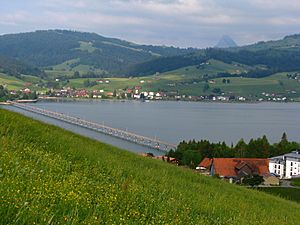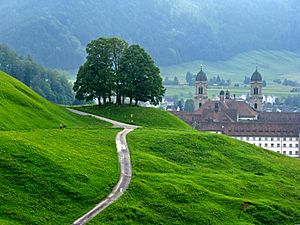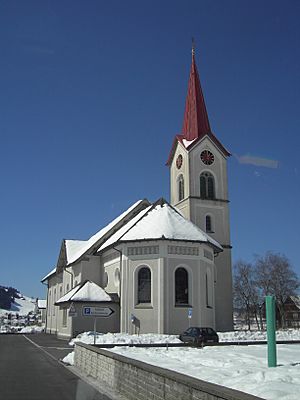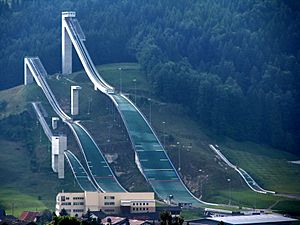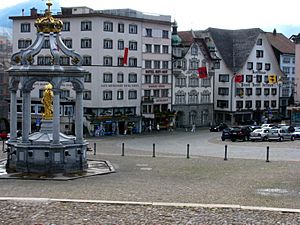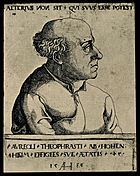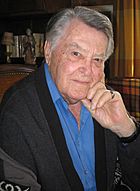Einsiedeln facts for kids
Quick facts for kids
Einsiedeln
|
||
|---|---|---|
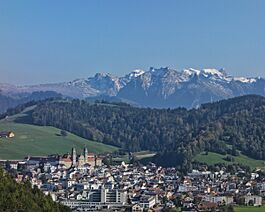
Einsiedeln town with the Benedictine Abbey
|
||
|
||
| Country | Switzerland | |
| Canton | Schwyz | |
| District | Einsiedeln | |
| Area | ||
| • Total | 98.93 km2 (38.20 sq mi) | |
| Elevation | 882 m (2,894 ft) | |
| Population
(Dec 2020 )
|
||
| • Total | 16,247 | |
| • Density | 164.227/km2 (425.35/sq mi) | |
| Postal code |
8840
|
|
| Localities | Bennau, Egg, Euthal, Gross, Trachslau, Willerzell and Biberbrugg (shared with the municipality Feusisberg) | |
| Surrounded by | Alpthal, Altendorf, Feusisberg, Freienbach, Innerthal, Oberägeri (ZG), Oberiberg, Rothenthurm, Unteriberg, Vorderthal | |
Einsiedeln is a town and district in the canton of Schwyz in Switzerland. It is famous for its old monastery, the Benedictine Einsiedeln Abbey. This monastery was built way back in the 10th century!
Contents
History of Einsiedeln
How Einsiedeln Started
Even before the Middle Ages, people didn't live permanently in the Einsiedeln area. But we know hunters lived there thousands of years ago. They left behind tools and items from the Stone Age and Bronze Age.
The story of Einsiedeln begins with St. Meinrad. He was a Benedictine monk from a noble family. Legend says Meinrad lived as a hermit on Mt. Etzel from 835 until he died in 861. A hermit is someone who lives alone, often for religious reasons.
After St. Meinrad, other hermits followed his example. One of them, Eberhard, started building a monastery and church in 934. He became the first abbot (leader) of the monastery. The new church was dedicated to the Virgin Mary.
When the Abbey was founded, local hunters and farmers decided to live under the Abbot's rule. These people were called Waldleute, meaning "forest people," because of the many forests around the Abbey. The Abbey encouraged them to settle in villages and start farming. The town of Einsiedeln was first mentioned in 1073.
People in the area also started raising cattle in the alpine valleys. This became very important for the village. By 1250, cattle farming was the main business. As they needed more land for grazing, this led to long conflicts with the nearby region of Schwyz.
Einsiedeln and the Old Swiss Confederacy
Conflicts over land between Einsiedeln and Schwyz started as early as 1100. These arguments led to many court cases and even battles. When the Habsburgs took control of Schwyz in 1173, and then made the Abbey an independent area under their rule in 1283, the local fights became bigger.
In 1291, Schwyz, Uri, and Unterwalden rebelled against the Habsburgs. In 1314, the land conflict flared up again when Schwyz attacked Einsiedeln. This attack helped cause the Battle of Morgarten in 1315, where the Habsburgs were defeated. The border between Einsiedeln and Schwyz was finally decided in 1350.
In 1394, the Abbey came under the protection of Schwyz. This meant Schwyz handled serious legal cases, but the Abbey still handled smaller local issues.
Einsiedeln is also the birthplace of Paracelsus. He was a famous doctor and alchemist during the Renaissance. He is known for being the first person to name the element zinc.
Over time, a council called the Drei Teile ("Three Parts") was formed. It included the Abbey, the Waldleute (local villagers), and Schwyz. This council helped manage issues affecting the free villagers. In 1564, they could make rules that all three groups had to follow.
However, things weren't always peaceful. In 1764, the Abbot tried to stop skilled workers from settling in the villages. This led to a revolt, which Schwyz helped the Abbey crush in 1766. After this, the Abbey lost much of its independence and was treated more like a part of Schwyz.
Modern Einsiedeln
During the French invasion of Switzerland in 1798, the Abbey was closed for about three years. Its land became part of the city of Schwyz. After the French left, Einsiedeln became a district in the Canton of Schwyz in 1803.
Later, the Abbey's power grew again. But some districts wanted reforms and formed their own liberal government in 1832. The Abbey supported the old, conservative ways. This caused tension with the surrounding villages until Switzerland became a federal state in 1848.
Geography of Einsiedeln
Einsiedeln is located in the valley of the Alp river. It includes six smaller areas: Bennau, Egg, Willerzell, Euthal, Gross, and Trachslau. Part of the village of Biberbrugg is shared with the town of Feusisberg.
Einsiedeln covers about 99.1 square kilometers (38.3 square miles). Almost half of this land (47.1%) is used for farming. A large part (44.5%) is covered by forests. The rest is built-up areas (5.5%) or non-productive land.
The town is about 7.5 kilometers (4.7 miles) from the southern end of the Lake of Zurich. It is also about 2 kilometers (1.2 miles) west of the man-made Sihlsee lake. Einsiedeln sits on a high plateau, about 880 meters (2,890 feet) above sea level. It is about 470 meters (1,540 feet) higher than Zürich, and there is a train connection between the two towns.
Einsiedeln is the main town and only municipality in its district.
People of Einsiedeln (Demographics)
Einsiedeln has a population of about 16,000 people. About 13.4% of the people living here are from other countries. Over the last 10 years, the population has grown by about 14.8%.
Most people in Einsiedeln (92.3%) speak German. Serbo-Croatian is the second most common language (1.9%), followed by Albanian (1.4%).
In 2000, about 50.4% of the population was male and 49.6% was female. About a quarter of the population (25.4%) is under 19 years old. About 28.7% are between 20 and 39, and 31.4% are between 40 and 64. About 14.3% of the population is 65 or older.
There are over 5,000 households in Einsiedeln. About a third of these (32.4%) have only one person living in them. About 6.8% are large households with five or more members.
In the 2007 election, the most popular political party was the SVP, which got 43.5% of the votes.
Most people in Switzerland are well-educated. In Einsiedeln, about 66% of adults (aged 25-64) have finished high school or gone on to higher education, like university.
Einsiedeln has a low unemployment rate of 1.29%. In 2005, about 551 people worked in farming. About 1,630 people worked in manufacturing and industry. And about 3,017 people worked in services, like shops, hotels, and offices.
According to the 2000 census, about 77.9% of the people in Einsiedeln are Roman Catholic. About 9.8% belong to the Swiss Reformed Church (a Protestant church). There are also people who belong to the Orthodox Church (2.28%) and Islam (2.63%). About 3.85% of the population said they did not belong to any church.
Historic Population of Einsiedeln
Here's how the population of Einsiedeln has changed over the years:
| year | population |
|---|---|
| 1799 | 4,958 |
| 1850 | 6,821 |
| 1880 | 8,383 |
| 1900 | 8,496 |
| 1930 | 8,053 |
| 1950 | 8,423 |
| 1960 | 8,792 |
| 1970 | 10,020 |
| 1980 | 9,529 |
| 1985 | 9,783 |
| 1990 | 10,452 |
| 2000 | 12,421 |
| 2005 | 13,365 |
| 2007 | 13,768 |
Transport in Einsiedeln
Einsiedeln is the last stop on the Wädenswil–Einsiedeln railway line. This line is part of the Zürich S-Bahn (a local train system). You can catch trains like the S13 and S40 here.
At the nearby Biberbrugg station, you can connect to other trains. For example, the Voralpen Express goes to Lucerne and St. Gallen. From Wädenswil station, you can get trains to Zürich.
Climate in Einsiedeln
Einsiedeln gets a lot of rain and snow. Between 1961 and 1990, it rained or snowed on about 156.7 days each year. The total amount of precipitation was about 1753 millimeters (69 inches) per year.
June was the wettest month, with about 206 millimeters (8.1 inches) of rain. It rained for about 15.3 days in June. February was the driest month, with about 108 millimeters (4.3 inches) of precipitation.
| Climate data for Einsiedeln (1991–2020) | |||||||||||||
|---|---|---|---|---|---|---|---|---|---|---|---|---|---|
| Month | Jan | Feb | Mar | Apr | May | Jun | Jul | Aug | Sep | Oct | Nov | Dec | Year |
| Mean daily maximum °C (°F) | 2.3 (36.1) |
3.3 (37.9) |
7.1 (44.8) |
11.2 (52.2) |
15.4 (59.7) |
19.0 (66.2) |
21.0 (69.8) |
20.6 (69.1) |
16.1 (61.0) |
12.2 (54.0) |
6.8 (44.2) |
3.1 (37.6) |
11.5 (52.7) |
| Daily mean °C (°F) | −1.5 (29.3) |
−1.1 (30.0) |
2.6 (36.7) |
6.6 (43.9) |
10.8 (51.4) |
14.4 (57.9) |
16.2 (61.2) |
16.0 (60.8) |
11.9 (53.4) |
7.9 (46.2) |
2.9 (37.2) |
−0.4 (31.3) |
7.2 (45.0) |
| Mean daily minimum °C (°F) | −5.3 (22.5) |
−5.3 (22.5) |
−1.8 (28.8) |
1.8 (35.2) |
6.0 (42.8) |
9.7 (49.5) |
11.6 (52.9) |
11.4 (52.5) |
7.7 (45.9) |
4.1 (39.4) |
−0.6 (30.9) |
−4.0 (24.8) |
2.9 (37.2) |
| Average precipitation mm (inches) | 99 (3.9) |
100 (3.9) |
122 (4.8) |
117 (4.6) |
176 (6.9) |
186 (7.3) |
196 (7.7) |
193 (7.6) |
144 (5.7) |
115 (4.5) |
115 (4.5) |
128 (5.0) |
1,690 (66.5) |
| Average snowfall cm (inches) | 50 (20) |
64 (25) |
41 (16) |
20 (7.9) |
1 (0.4) |
0 (0) |
0 (0) |
0 (0) |
0 (0) |
4 (1.6) |
30 (12) |
53 (21) |
263 (104) |
| Average precipitation days (≥ 1.0 mm) | 12.1 | 11.2 | 13.3 | 12.1 | 14.5 | 14.8 | 14.3 | 13.1 | 11.6 | 10.7 | 11.5 | 13.3 | 152.5 |
| Average snowy days (≥ 1.0 cm) | 8.7 | 8.5 | 6.4 | 3.2 | 0.4 | 0.0 | 0.0 | 0.0 | 0.0 | 0.6 | 4.4 | 8.1 | 40.3 |
| Average relative humidity (%) | 85 | 82 | 80 | 76 | 78 | 77 | 76 | 78 | 83 | 84 | 86 | 86 | 81 |
| Source: MeteoSwiss | |||||||||||||
Sports in Einsiedeln
Schanzen Einsiedeln is Switzerland's national ski jumping center. This is where top athletes practice and compete!
Tourism in Einsiedeln
Einsiedeln is a popular place for tourists in central Switzerland. The Benedictine Einsiedeln Abbey is a very important pilgrimage site for Roman Catholics in Europe. It's often called "the most important place of pilgrimage dedicated to the Virgin Mary in Switzerland."
The Graces Chapel and a statue of the Black Madonna have been the main attractions for pilgrims since the Middle Ages. A copy of this famous statue can even be found in the French Jura town of Pontarlier. Between 150,000 and 200,000 pilgrims visit the Graces Chapel every year.
Besides being a pilgrimage site, Einsiedeln is also great for sports all year round. In winter, it's a popular spot for winter sports. The village has its own ski jump, ski lifts, and winter sports centers in the nearby areas of Hoch-Ybrig and Brunni. You can also find the Schwedentritt cross-country skiing trail right next to the Einsiedeln Abbey.
In summer, the nearby Sihlsee reservoir is used for swimming, surfing, and sailing. In winter, it's a great place for ice-skating. The dam that holds the lake back helps produce electricity for trains and protects Zürich from floods.
Today, fewer pilgrims visit Einsiedeln than in the past. But the town has become very popular with day tourists. They come for the clean air and beautiful mountain views. Because of the great quality of life, the population of Einsiedeln is growing faster than in many other parts of Switzerland.
Notable People from Einsiedeln
- Paracelsus (1493 in Egg – 1541), a famous doctor and alchemist from the German Renaissance. He was the first to name zinc.
- Artur Beul (1915–2010), a Swiss songwriter.
- Lee Scratch Perry (1936–2021), a famous Jamaican music producer and musician.
- Andreas Küttel (born 1979), a Swiss former Ski Jumper who became "World Champion 2009".
Images for kids
See also
 In Spanish: Einsiedeln para niños
In Spanish: Einsiedeln para niños






